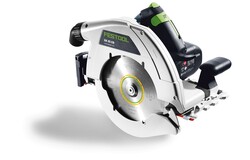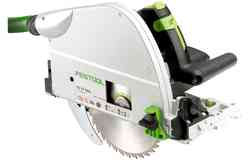Cutting layered boards using the circular saw

Description
This illustrated guide explains how to saw layered boards that are up to 80 mm thick. Layered boards can be machined safely and easily using the HK circular saw and the guide rail.
Tools/accessories
Alternative tools
Preparation/set-up
-
When cutting layered elements, you must ensure that you use suitable safety equipment. It is extremely important that you wear safety goggles to protect your eyes from metal chips. Wear ear protection during work and wear protective gloves when handling the material.
Note: When using a mobile dust extractor, you must be aware that sparks may be created during sawing and cutting work. For this reason, you should use a spark trap, replace the filter bag before starting work and use a suction hose measuring at least 5 m.
-
First, change the saw blade. When machining steel and iron sheets, always use the recommended flat-toothed saw blade. If the outer layer of the layered material is made of aluminium, the corresponding aluminium saw blade must be used.

-
The next step is marking the cutting edge.

-
The guide rail is secured on the material at the correct position using clamps. The length of the guide rail should be chosen so that the machine can be securely positioned in front of the layered boards for cutting.

Procedure
-
The machine is placed securely on the guide rail and moved slowly and evenly through the material. If necessary, the HK circular saw can also be used to produce cut-outs in the material, e.g. for windows.

-
The result of this cutting step is a clean, precise cut in the layered boards. This step can be carried out on-site if needed.

-
Our illustrated guides and work results are documented working steps that we have performed in practice. They are individual examples and do not guarantee or promise that users will obtain the same results. The results will depend on the user's experience and skill, as well as the material being used. Illustrated guides do not replace any Festool operating manuals and/or safety instructions. Liability for ensuring that the information, instructions and applications are free from content defects and defects of title, in particular with regard to the absence of defects, correctness, freedom from third party intellectual property rights and copyrights, completeness and fitness for purpose, is excluded. Claims for damages made by the user, regardless of their legal basis, are excluded. These liability exclusions are not applicable if the damage was intentional or caused by gross negligence, or in cases of statutory liability.
We cannot accept liability for damage resulting from defects.↑










































